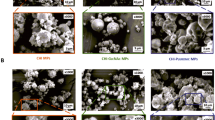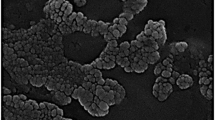Abstract
Helicobacter pylori infection is currently known to be the cause of at least 75% of all peptic ulcers. Although triple therapy protocols used at present in the clinics have resulted in significant benefits to the patients, the ultimate 100% eradication efficiency has never been achieved. In addition, the development of multidrug resistance to standard anti-microbial therapy can seriously hinder effective management of the disease. A rational approach to treat H. pylori, which localizes predominantly in the antral region of the stomach, is necessary for complete eradication of the infection. In this article, I review the summary of our work over the last several years on development of stomach-specific anti-H. pylori therapy using bioadhesive chitosan microspheres. To determine the gastric residence and local tetracycline concentrations as a function of time, tetracycline-containing chitosan microspheres were formulated and evaluated using the fasted Mongolian gerbil model. The H. pylori-infected gerbil model was used to evaluate the efficacy of the tetracycline-containing chitosan microsphere formulation. These preliminary results show great promise for this delivery strategy in the treatment of localized gastro-intestinal tract infections. Drug carrier systems can be engineered with the appropriate therapeutic agent(s) for efficient delivery to the target site and provide better control over localized infectious diseases. This strategy will ultimately lead to favorable clinical outcomes with less potential for resistance development.
Similar content being viewed by others
References
Bell G.D., Powell K., Burridge S.M., Pallecaros A., Jones P.H., Gant P.W., Harrison G., Trowell J.E. (1992). Experience with “triple” anti Helicobacter pylori eradication therapy: side effects and the importance of testing the pre-treatment bacterial isolate for metronidazole resistance. Aliment. Pharmacol. Ther. 6:427–435
Bingel S.A. (1995). Pathologic findings in an aging Mongolian gerbil (Meriones unguiculatus) colony. Lab. Anim. Sci. 45:597–600
Blaser M.J. (1987). Gastric Campylobacter-like organisms, gastritis and peptic ulcer disease. Gastroenterology 93:371–383
Blaser M.J. (1990). Helicobacter pylori and the pathogenesis of gastroduodenal inflammation. J. Infect. Dis. 161:626–633
Chandy T., Sharma C.P. (1990). Chitosan – as a biomaterial. Biomat. Art. Cells. Art. Org. 18:1–24
Claesson P.M., Ninham B.W. (1992). pH-dependent interactions between adsorbed chitosan layers. Langmuir 8:1406–1412
Domard A., Cartier N. (1992). Glucosamine oligomers: IV. Solid state-crystallization and sustained dissolution. Int. J. Biol. Macromol. 14:100–106
Dore M.P., Sepulveda A.R., Mura I., Realdi G., Osato M.S., Graham D.Y. (1997). Explanation for variability of omeprazole amoxicillin therapy? Tolerance of H. pylori to amoxicillin. Gastroenterology 112:A105
Eaton K.A., Morgan D.R., Krakowka S. (1994). Campylobacter pylori virulence factors in gnotobiotic piglets. Infect. Immun. 57:1119–1125
Forman D., Newell D.G., Fullerton F., Yarnell J.W., Stacey A.R., Wald N., Sitas F. (1991). Association between infection with Helicobacter pylori and risk of gastric cancer: evidence from a prospective investigation. Br. Med. J. 302:1302–1305
H. pylori and peptic ulcer disease. 2003. URL http://www.cdc.gov/ulcer/md.htm#fda. (10/10/2003)
Hazell S.L., Lee A., Brady L. (1986). Campylobacter pyloridis and gastritis: association with intracellular spaces and adaptation to an environment of mucus as important factors in colonization of the gastric epithelium. J. Infect. Dis. 153:658–663
Hejazi R. and Amiji M. 2001. Chitosan-based delivery systems: physicochemical properties and pharmaceutical applications. In: Dumitriu S. (ed.), Polymeric Biomaterials. Second Edition, Revised and Expanded. Marcel Dekker, Inc., New York, NY, Chapter 10, pp. 213–238
Hejazi R., Amiji M. (2002). Stomach-specific anti-H. pylori therapy. I: preparation and characterization of tetracycline-loaded chitosan microspheres. Int. J. Pharm. 235(1–2):87–94
Hejazi R., Amiji M. (2003a). Chitosan-based gastrointestinal delivery systems. J. Control. Release 89:151–165
Hejazi R., Amiji M. (2003b). Stomach-specific anti-H. pylori therapy. II: gastric residence studies of tetracycline-loaded chitosan microspheres in gerbils. Pharm. Dev. Technol. 8:253–262
Hejazi R., Amiji M. (2004). Stomach-specific anti-H. pylori therapy. III: effect of chitosan microsphere crosslinking on the gastric residence and local tetracycline concentrations in fasted gerbils. Int. J. Pharm. 272(1–2):99–108
Hirano S., Seino H., Akiyama Y., Nonaka I. (1990). Chitosan: a biocompatible material for oral and intravenous administrations. In: Gebelein C.G., Dunn R.L. (eds), Progress in Biomedical Polymers. Plenum Press, New York NY, pp. 283–290
Hoppe-Seiler F. (1994). Chitin and chitosan. Ber. Deutsch Chem. Ges. 27:3329–3331
Hunt R.H. (1995). Helicobacter pylori eradication: a critical appraisal and current concerns. Scand. J. Gastroenterol. 30:73–76
Ikeno T., Ota H., Sugiyama A., Ishida K., Katsuyama T., Genta R.M., Kawasaki S. (1999). Helicobacter pylori-induced chronic active gastritis, intestinal metaplasia, and gastric ulcer in Mongolian gerbils. Am. J. Pathol. 154:951–960
Ito M., Ban A., Ishihara M. (2000). Anti-ulcer effects of chitin and chitosan, healthy foods, in rats. Jpn. J. Pharmacol. 82:218–225
Knapczk J., Krowczynski L., Pawlik B., Liber Z. (1984). Pharmaceutical dosage forms with chitosan. In: Skjak-Braek G., Anthonsen T., Sandford P. (eds), Chitin and Chitosan: Sources, Chemistry, Biochemistry, Physical Properties and Applications. Elsevier Applied Science, London, UK, pp. 665–669
Lee A. (1999). Animal models of Helicobacter infection. Mol. Med. Today 5:500–501
Lehr C.M., Bouwstra J.A., Schacht E., Junginger H.E. (1992). In vitro evaluation of mucoadhesive properties of chitosan and some other natural polymers. Int. J. Pharm. 78:43–48
Levy S.B. (1992). The Antibiotic Paradox: How Miracle Drugs are Destroying the Miracle. Plenum Press Inc., New York, NY
Malfertheiner P. (1993). Compliance, adverse events, and antibiotic resistance in Helicobacter pylori treatment. Scand. J. Gastroenterol. 28:34–37
Marshall B.J. (1983). Unidentified curved bacilli in gastric epithelium in active chronic gastritis. Lancet 1:1273–1275
Marshall B.J., Warren J.R. (1984). Unidentified curved bacilli in the stomach of patients with gastritis and peptic ulceration. Lancet 1:1311–1315
Matsumoto S., Washizuka Y., Matsumoto Y., Tawara S., Ikeda F., Yokota Y., Karita M. (1997). Induction of ulceration and severe gastritis in Mongolian gerbil by Helicobacter pylori infection. J. Med. Microbiol. 46:391–397
Megraud F. 1994. Helicobacter pylori resistance to antibiotics. In: Hunt R.H. and Tytgat Guido N.J. (eds), Helicobacter pylori: Basic Mechanisms to Clinical Cure. Kluwer Academic Publishers, Dordrecht, The Netherlands, pp. 570–583
Mergaud F., Trimoulet P., Lamouliatte H., Boyanova L. (1991). Bactericidal effect of amoxicillin on Helicobacter pylori in an in vitro model using epithelial cells. Antimicrob. Agents Chemother. 35:869–872
Miyazaki S., Nakayama A., Oda M., Takada M., Attwood D. (1994). Chitosan and sodium alginate based bioadhesive tablets for intraoral drug delivery. Biol. Pharm. Bull. 17:745–747
NIH Consensus Conference (1994). Helicobacter pylori in peptic ulcer disease. NIH Consensus Development Panel on Helicobacter pylori in peptic ulcer disease. JAMA 272:65–69
Nomura A.M., Stemmermann G.N., Chyou P.H., Kato I., Perez-Perez G.I., Blaser M.J. (1991). Helicobacter pylori infection and gastric carcinoma among Japanese Americans in Hawaii. N. Engl. J. Med. 325:1132–1136
Parsonnet J., Friedman G.D., Vandersteen D.P., Chang Y., Vogelman J.H., Orentreich N., Sibley R.K. (1991). Helicobacter pylori infection and the risk of gastric carcinoma. N. Engl. J. Med. 325:1127–1131
Patel V.R., Amiji M.M. (1996a). pH-sensitive swelling and drug release properties of chitosan-poly(ethylene oxide) semi-interpenetrating polymer network. In: Ottenbrite R., Huang S., Park K. (eds), Hydrogels and Biodegradable Polymers for Bioapplications Volume 627. American Chemical Society Syposium Publication, Washington, DC, pp. 209–220
Patel V.R., Amiji M.M. (1996b). Preparation and characterization of freeze-dried chitosan-poly(ethylene oxide) hydrogels for site-specific antibiotic delivery in the stomach. Pharm. Res. 13:588–593
Patel V.R., Amiji M.M. (1996c). pH-sensitive swelling and drug release properties of chitosan-poly(ethylene oxide) semi-interpenetrating polymer network. In: Ottenbrite R., Huang S., Park K. (eds), Hydrogels and Biodegradable Polymers for Bioapplications Volume 627. American Chemical Society Symposium Series Publication. American Chemical Society, Washington, DC, pp 209–220
Peterson W.L., Graham D.Y., Marshall B., Blaser M.J., Genta R.M., Klein P.D., Stratton C.W., Drnec J., Prokocimer P., Siepman N. (1993). Clarithromycin as monotherapy for eradication of Helicobacter pylori: a randomized, double-blind trial. Am. J. Gastroenterol. 88:1860–1864
Qaqish R.B., Amiji M.M. (1999). Synthesis of fluorescent chitosan derivative and its application for the study of chitosan–mucin interactions. Carbohyd. Polym. 38:99–107
Reddy R., Osato M., Gutierrez O., Kim J.G., Graham D.Y. (1996). Metronidazole resistance is high in Korea and Columbia and appears to be rapidly increasing in the US. Gastroenterology 10:A236
Rha C.K., Rodriguez-Sanchez D., Kienzle-Sterzer C. (1984). Novel applications of chitosan. In: Colwell R.R., Pariser E.R., Sinskey A.J. (eds), Biotechnology of Marine Polysaccharides. Hemisphere Publishing, Washington, DC, pp. 284–311
Roberts G.A.F. (1992). Solubility and solution behaviour of chitin and chitosan. In: Roberts G.A.F. (ed.), Chitin Chemistry. MacMillan Press, Houndmills, pp. 274–329
Roberts G.A.F. (1992). Structure of chitin and chitosan. In: Roberts G.A.F. (ed.), Chitin Chemistry. MacMillan Press, Houndmills, pp. 1–53
Talley N.J., Zinsmeister A.R., Weaver A., DiMagno E.P., Carpenter H.A., Perez-Perez G.I., Blaser M.J. (1991). Gastric adenocarcinoma and Helicobacter pylori infection. J. Natl. Cancer Inst. 83:1734–1739
The United States Pharmacopeia/National Formulary. 1990. Volume XXII. The United States Pharmacopeial Convention, Inc. Rockville, MD, 1788 pp
Tytgat G.N.J., Noach L., Rauws E.A.J. (1991). Helicobacter pylori. Scand. J. Gastroenterol. 26:1–8
Vasquez A., Valdez Y., Gilman R.H., McDonald J.J., Westblom T.U., Berg D., Mayta H., Gutierrez V. (1996). Metronidazole and clarithromycin resistance in Helicobacter pylori determined by measuring MICs of antimicrobial agents in color indicator egg yolk agar in a miniwell format. J. Clin. Microbiol. 34:1232–1234
Worthington J.M., Fulghum R.S. (1988). Cecal and fecal bacterial flora of the Mongolian gerbil and the chinchilla. Appl. Environ. Microbiol. 54:1210–1215
Yalpana M., Pantaleone D. (1994). An examination of the unusual susceptibilities of aminoglycans to enzymatic hydrolysis. Carbohyd. Res. 256:159–175
Yao K.D., Peng T. (1994). Swelling kinetics and release characteristics of crosslinked chitosan:polyether polymer network (semi-IPN) hydrogels. J. Polym. Sci., Part A: Polym. Chem. 32:1213–1223
Acknowledgements
This work was partially supported by the National Institutes of Health SBIR Phase I subcontract funding from EOS Pharmaceuticals (Woburn, MA) and by Northeastern University through the Research and Scholarship Development Grant. The author is deeply appreciative of the collaborations with Dr David Cave when he was the Chief of Gastroenterology at Saint Elizabeth’s Medical Center in Boston (currently at University of Massachusetts Medical Center, Worcester, MA) and Dr Masae Tatematsu and his co-workers at the Aichi Cancer Center in Nagoya, Japan. In addition, many graduate students in the author’s laboratory have been involved in these studies and their participation is gratefully acknowledged.
Author information
Authors and Affiliations
Corresponding author
Rights and permissions
About this article
Cite this article
Amiji, M.M. Tetracycline-containing Chitosan Microspheres for Local Treatment of Helicobacter pylori Infection. Cellulose 14, 3–14 (2007). https://doi.org/10.1007/s10570-006-9070-3
Received:
Accepted:
Published:
Issue Date:
DOI: https://doi.org/10.1007/s10570-006-9070-3




